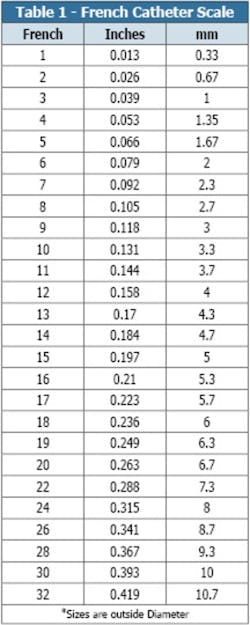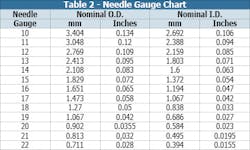Double pouching results in corrective action citation; Understanding channel and lumen sizing
Submit your questions
email: [email protected]
phone: (941) 927-9345 ext. 202
Q During a recent accreditation inspection one of our offsite ambulatory health centers received a corrective action citation for double pouching some instruments in peel pouches. The surveyor claimed the IFU did not include instructions for such application. I provided them a letter I had from my sales rep that said we could double pouch if there was a need. The surveyor said that the letter was not a valid document and we were using the product off label. I am not sure what that means. We have always double pouched items for offsite locations for added protection, with no problems. Now I have to provide a corrective action plan and/or appropriate documentation allowing double pouching. I am not sure what more I can do as I have already provided the rep’s letter. Every place I have ever worked has double pouched some items. I think the surveyor was off track. What are your thoughts on this?
A Over the past year I have heard of several hospitals being cited for double pouching. Using a product off label in this case means that you are using a product in an unapproved manner or application. As you know, sterile packaging materials or devices are a class 2 medical device. As part of the FDA 510 (k) processes they must demonstrate the ability allow the permeation of defined sterilants adequately into the package and achieve sterilization of the package contents. The packaging device must also prove the ability to maintain sterility of contents until used. Unless a peel pouch has been validated for double pouching it should not be used in that manner. It should be noted that most peel pouch brands do not have such clearance or validation for double pouch use. At this writing I know of only one manufacturer that has appropriate validation.
A letter from a sales representative is not considered a validation document. A product’s validation ideally would be conducted by an independent laboratory. The validation report would provide all of the details of testing, method(s) of packaging, sterilization parameters, including pre- and post-sterilization biological results. The IFU should clearly state the product has been validated for double pouching (referencing source). The instructions should include applicable protocol of how to double pouch (e.g., sizing of inner and outer pouches, sealing, placement and positioning of inner and outer pouches). My advice to you is to reexamine your rationale and need to double pouch. Contact your manufacturer for validation documentation for double pouching and for appropriate instructions for such use. If your manufacturer cannot provide you with this documentation you should immediately stop double pouching. If you feel the need to double pouch some items then you should find a peel pouch that has appropriate validation.
Q Like any other sterile processing department we deal with a myriad of medical devices and suction apparatuses with lumens and channels of various sizes. Each of these devices requires brushing to clean the inner channels. We encounter a lot of problems and confusion when trying to determine the correct size device and cleaning brush to purchase and use. There doesn’t seem to be any standardization in nomenclature in sizing. Some manufacturers identify products using French dimensions while others use millimeter or gauge. I am trying to make sense of all of this. Is there any correlation between these sizing methods or a means to understand all this more simply?
A I appreciate and understand your sense of confusion. Some devices are sized according to their Nominal I.D. which is the inner dimension of the channel while other items are sized according to their Nominal O.D. which is the outer dimensions of the device.
The standard French,(Fr) or Charriere, sizing scale is generally used in the calibration of catheters, probes and other tubular instruments. It is based on the metric system, with each unit of measure being approximately 1/3 (0.33) mm in diameter between consecutive sizes generally from 0.33mm — 10mm (1 — 30 Fr). One Charrière (symbol, Fr) equals 1⁄3 millimeter – Thus a 3-charrière (Fr) catheter would have a diameter of 1 millimeter (see Table 1).
version
By convention, needles or single lumen catheters are sized by gauge and multi-lumen catheters are measured by French size. While French size and diameter are related directly, gauge and size are related inversely; a lower gauge indicates a greater diameter. Gauge designations generally go no lower than (bigger than) 10 ga. Standards exist for the inner and outer diameters of needles of a particular gauge, but standards exist only for the outer diameter of catheters, even those with a single lumen (see Table 2).
version
Caution must be exercised when considering catheter/needle and guide wire combinations. This is also true with the selection of appropriate sized cleaning brushes for various channeled and lumen devices including endoscopes. It is essential that you consult the manufacturer’s specifications and instructions for use to ascertain sizing and guidance in the selection of the appropriate accessory items. Some manufacturers have color-coded their products to correspond to cleaning brushes and sizing. Others can provide sizing poster and measuring tools to simplify the selection and use of the proper devices.
Ray Taurasi is Principal, Healthcare CS Solutions. His healthcare career spans over three decades as an Administrator, Educator, Technologist and Consultant. He is a member of AORN, AHA, SGNA, AAMI and a past president of IAHCSMM. Taurasi has been a faculty member of numerous colleges teaching in the divisions of business administration and health sciences.
About the Author

Ray Taurasi
Ray Taurasi is Principal, Healthcare CS Solutions. His healthcare career spans over five decades as an Administrator, Educator, Technologist and Consultant. He is a member of AORN, SGNA, AAMI and a past president of IAHCSMM. Taurasi has been a faculty member of numerous colleges teaching in the divisions of business administration, nursing, and health sciences. He is the author of numerous articles and textbook chapters; he is a frequent speaker at national and international healthcare conferences.
Note to readers from Ray Taurasi - In 2021, my life’s career path will transition to one of new opportunities and adventures. As a result, after nearly 19 years and 225 CS Solution columns, this edition will be my last.
“All changes, even the most longed for, have their melancholy; for what we leave behind us is a part of ourselves; we must die to one life before we can enter another.”– Anatole France
I wish you and your loved ones a healthy and joyful holiday season and a beautiful New Year! God Speed, Ray
https://www.facebook.com/pages/category/ Local-Business/Healthcare-CS-Solutions-128857 3061153887/ • email: [email protected]


